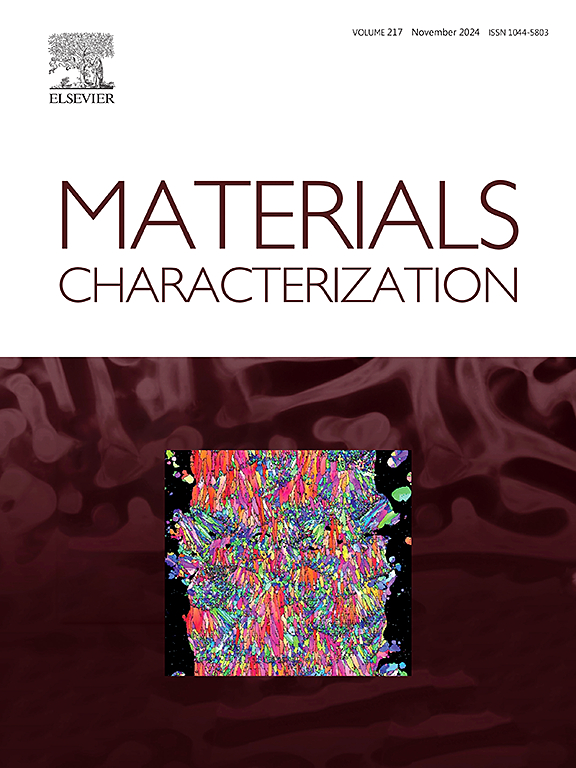Improvement of intermetallic compounds of TC4/QP980 joints using a flexible dual-beam laser heat source
IF 4.8
2区 材料科学
Q1 MATERIALS SCIENCE, CHARACTERIZATION & TESTING
引用次数: 0
Abstract
In this paper, the well-performed QP980/TC4 lap joint without Fe-Ti intermetallic compounds was successfully obtained by using coaxial pulse-continuous dual-beam laser welding heat source and CuSi3 filler wire. The interface microstructure, mechanical properties and the effect of dual-beam laser power density on the joint were systematically studied. The mechanical properties of the joints increased first and then decreased with the increase of laser power density. The maximum tensile peak tensile load value reached 3820 N/cm and the average measured thickness of the reaction layer at the TC4 interface was 129.7 μm under the central power density of 1480 W/mm2 and the surrounding power density of 80 W/mm2. The joints were all fractured at the TC4 interface, which was cleavage fracture. The microstructure of TC4 interface was (Cu)ss/Ti5Si3/TiCu/Ti2Cu + TiCu/α + β-Ti. On the base of experiments and thermodynamic calculations of TC4 interface, the chemical potential of Ti and Cu is small when the molar concentration of Si is high, so Ti and Cu tend to transfer to the Si-rich region. It can inhibit the thickness of intermetallic compounds layer at the TC4 interface. However, the hardness of Ti5Si3 and TiCu were so high that stress concentration occurred to cause large the residual stress in joints. The fracture behavior of TC4 interface was further analyzed, and the hard brittle phase Ti5Si3 might become the crack source. Ti5Si3 (001)/TiCu (111) and Ti5Si3 (001)/Cu (111) possible matching planes were non-coherent, which might become the crack propagation path.
利用柔性双光束激光热源改进TC4/QP980接头的金属间化合物
采用同轴脉冲连续双光束激光焊接热源和CuSi3填充焊丝,成功制备了性能良好的不含Fe-Ti金属间化合物的QP980/TC4搭接接头。系统地研究了双光束激光功率密度对接头界面组织、力学性能的影响。随着激光功率密度的增大,接头的力学性能呈现先升高后降低的趋势。在中心功率密度为1480 W/mm2,周围功率密度为80 W/mm2的条件下,TC4界面处的反应层平均厚度为129.7 μm,最大拉伸峰值达到3820 N/cm。接头均在TC4界面处断裂,为解理断裂。TC4界面微观结构为(Cu)ss/Ti5Si3/TiCu/Ti2Cu + TiCu/α + β-Ti。根据TC4界面的实验和热力学计算,当Si的摩尔浓度较高时,Ti和Cu的化学势较小,因此Ti和Cu倾向于向富Si区转移。它能抑制TC4界面处金属间化合物层的厚度。但Ti5Si3和TiCu的硬度过高,出现应力集中,导致接头残余应力较大。进一步分析了TC4界面的断裂行为,认为硬脆相Ti5Si3可能成为裂纹源。Ti5Si3 (001)/TiCu(111)和Ti5Si3 (001)/Cu(111)可能的匹配面为非相干面,可能成为裂纹扩展路径。
本文章由计算机程序翻译,如有差异,请以英文原文为准。
求助全文
约1分钟内获得全文
求助全文
来源期刊

Materials Characterization
工程技术-材料科学:表征与测试
CiteScore
7.60
自引率
8.50%
发文量
746
审稿时长
36 days
期刊介绍:
Materials Characterization features original articles and state-of-the-art reviews on theoretical and practical aspects of the structure and behaviour of materials.
The Journal focuses on all characterization techniques, including all forms of microscopy (light, electron, acoustic, etc.,) and analysis (especially microanalysis and surface analytical techniques). Developments in both this wide range of techniques and their application to the quantification of the microstructure of materials are essential facets of the Journal.
The Journal provides the Materials Scientist/Engineer with up-to-date information on many types of materials with an underlying theme of explaining the behavior of materials using novel approaches. Materials covered by the journal include:
Metals & Alloys
Ceramics
Nanomaterials
Biomedical materials
Optical materials
Composites
Natural Materials.
 求助内容:
求助内容: 应助结果提醒方式:
应助结果提醒方式:


